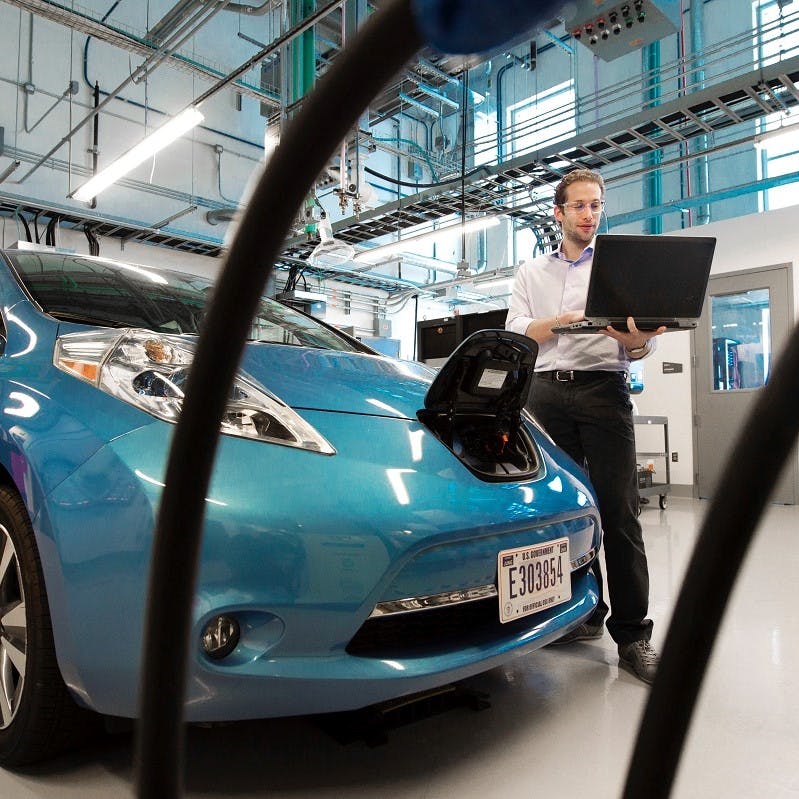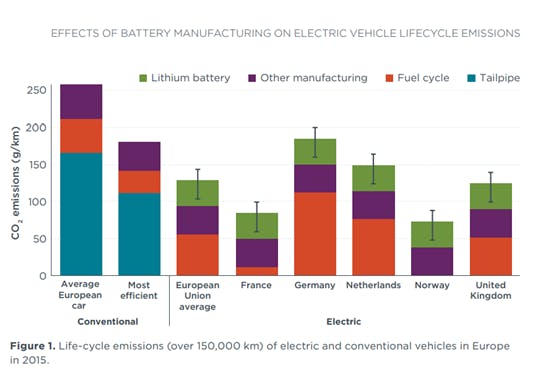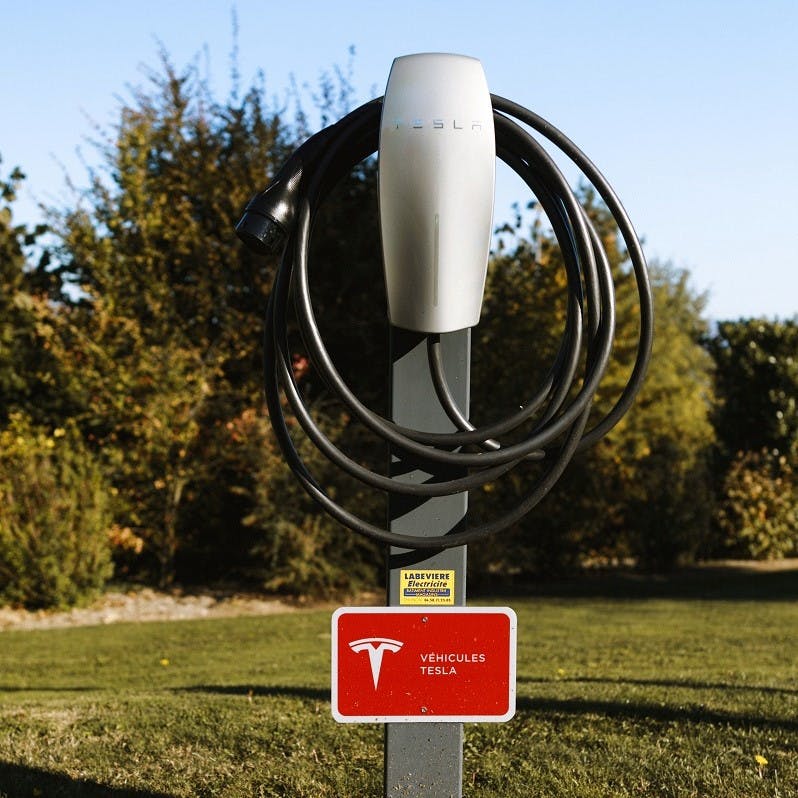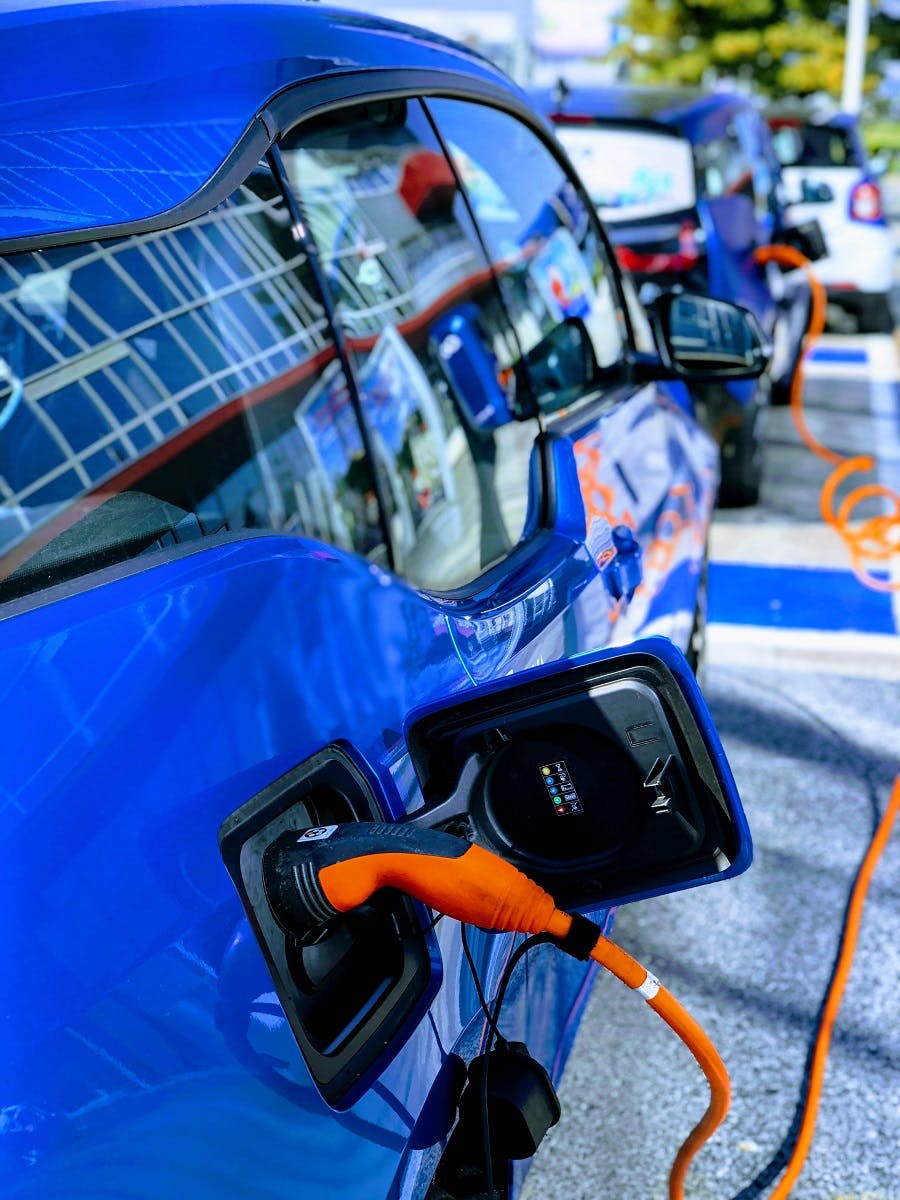
Tim
Electric vehicles are starting to fill roads around the world as manufacturers launch ever more impressive battery powered alternatives to compete with traditional petrol and diesel fuelled cars. But how likely is it that this electric revolution will completely replace conventional cars, what are the pros and cons, and how squeaky clean are they for the environment?
Carbon emissions: Electric vs Conventional cars
Since the 2015 Paris agreement set stringent climate change goals, governments have been scrambling to find ways of cutting greenhouse gas emissions. In the transportation industry, which is responsible for 13% of global emissions, the European Union has set a target of 59 grams of CO2 average car emissions to achieve by 2030. It’s been argued that electric vehicles have significantly lower emissions and hence are vital to achieving this extremely challenging target. However, their green credentials have often come under attack being branded ‘elsewhere emissions vehicles’. Therefore, before we jump on the electric bandwagon let’s see what drives emissions for both battery electric (BEVs) and petrol or diesel (internal combustion engines -ICEs) vehicles. The main areas of debate centre around the calculation of emissions created during the production and charging of EVs.

Manufacturing
The key to electric cars getting up to speed with their ICE counterparts in terms of performance, is the technology behind their lithium-ion batteries which power them. Unfortunately, these batteries come at an environmental cost. Firstly, they contain rare earth materials, and extracting and producing them can be water and electricity intensive processes. Currently, countries like China, who are still heavily reliant on coal, manufacture a large share of the world’s batteries. This major factor drives BEVs’ production emissions above those of conventional ICEs’. With this said, Europe and the US adopt more efficient manufacturing techniques (by approx. two thirds in the US) and are expected to become the norm. Secondly, there’s the question of how to deal with end of life batteries and their toxic waste. In light of this, research into second life uses and recycling of batteries is progressing and will be fundamental in bringing future emissions down. There’s also the hope that the trend of electric grids decarbonising will continue. Positive progress is already happening, check out Tesla’s gigafactory that commits to solely using renewables.



Take action now
Do you want to have a direct impact on climate change? Sir David Attenborough said the best thing we can do is to rewild the planet. So we run reforestation and rewilding programs across the globe to restore wild ecosystems and capture carbon.
Get involvedCharging
Another argument fuelling the fire for BEV skeptics is that electric vehicles charge on ‘dirty’ fossil fuelled power grids and can rack up emissions. So despite not polluting via tailpipe fumes they still cause emissions at the power plant. Even cleaner grids will rely on fossil fuels during ‘dark doldrums’ when renewables are intermittent. Despite this, an overall growing number of studies indicate that the average BEV has a smaller carbon footprint over the lifetime of the vehicle in most countries. In line with this claim, a report by the International Council on Clean Transport (ICCT) compares life cycle emissions of vehicles plugged into various European grids, as shown in figure 1.
According to the ICCT’s research, after production and 150,000km of driving the average electric vehicle in Europe produces 50% less emissions. That’s only 2 years of driving before you offset emissions against a petrol or diesel car. However, it’s worth noting that depending on the carbon density of a country’s power grid this can range from 28% to 72%. Therefore, the source of energy your electric vehicle uses should be a key factor if you want to consider your environmental impact. See this link to identify the energy mix of a range of countries.
Keep reading for additional electric cars pros and cons.

In order to have clean air in cities, you have to go electric
Elon Musk
Electric Cars Pros and Cons
Before you head down to your local showroom to test drive a BEV, take a look at these other environmental and performance-related pros and cons.
Energy efficiencies: BEVs convert over 77% of electrical energy from the grid to engine power, whereas ICEs convert only 12-30% of energy stored in gasoline.
No exhaust pipe flumes: less particulates, hydrocarbons, carbon monoxide, ozone, and other choking pollutants in the atmosphere.
Performance: benefits include stronger acceleration, quieter and smoother drive. The torque of Tesla’s P100 D has been said to give supercars like Lamborghini a run for its money!
More efficient mechanics: fewer break downs and potentially longer life cycles.
Cost savings from refuelling: Charging stations for BEVs are often cheaper than the price of petrol or diesel and, in some locations, your vehicle can be charged for free! If you have solar energy at home, you can charge cost and emissions free.

Charging times are reducing: Tesla has slashed charging times to 30 minutes with their innovative superchargers.
Some countries offer tax credits and grants on BEVs.
Limited range is no longer an issue: A single charge can last 115 miles for most BEVs. That should cover most people’s daily journeys.
The more power, the less eco-friendly: The most powerful BEVs such as the Tesla Model S, carry heavier batteries and therefore, generate significantly higher production emissions than ICEs.
The issue of sourcing rare earth elements for batteries is yet to be fully addressed: Will increased demand for electric vehicles deplete more natural resources?
Infrastructure needs to expand to support the expected boom in BEVs: This is especially the case for owners who live in apartments unable to charge from home.
Purchase prices: BEVs are still unaffordable for most. One of the cheapest is the Renault Zoe at £20,000 (with the UK government’s PiCG incentive). Bear in mind that low running costs could outweigh this though.

Which EV is for me?
As the electric vehicle market rapidly develops the choice is becoming greater making it a more daunting task of finding the right vehicle for you. Here is a breakdown of the current crop and different types of electric cars that are battling for pole position in the marketplace.
BEV – Battery Electric Vehicles that are 100% battery operated such as the highly regarded Tesla Models which will quench your need for speed. The choice for car enthusiasts is ever increasing with most major manufacturers rushing to release their own competitive versions. Popular models just to name a few include the Nissan Leaf, Renault Zoe, Hyundai Kona, Kia e-Niro, Jaguar I-Pace, BMW i3 (s), and iX3, Audi e-tron 55 quattro, Kia Soul EV but expect a whole host of new EVs to be on the market soon.
PHEV – Plug in Hybrid Electric Vehicles, although included as EVs their main power source is petrol or diesel. They can use their electric battery for short trips up to around 30 miles then the petrol or diesel engine kicks in. If you’re planning on driving further each day, you’ll still be burning fossil fuels. Examples of PHEVs include Mitsubishi Outlander, Volvo XC60 Twin Engine, BMW 225xe, Volkswagen Golf GTE, Toyota Prius Plug-in and Mercedes-Benz E350 e SE
HEV – Hybrid Electric Vehicles, as these are not plug-ins they have weaker batteries that operate as a ‘boost’ to the petrol or diesel engine often only activating during low speeds. The battery is charged while it drives using regenerative braking or via the burning of fuel in the engine therefore not such a clean choice. Some hybrids on the market include Toyota Corolla and Yaris Hybrids, Lexus RX450h, Ford Mondeo Hybrid, and Honda NSX.
HFCEV– Hydrogen Fuel Cell Electric Vehicle, technology that creates electricity when supplied with oxygen and hydrogen. Benefits include its clean credentials as it only emits water. Downsides are the risks involved with the storage of the gas itself and it is currently an expensive technology. As this vehicle type is in its infancy the range is small, examples include the Toyota Mirai, Hyundai Nexo, and Honda Clarity.

What’s further down the road…
If the global transition to electric vehicles plays out (the International Energy Agency predicts annual sales of 50 million by 2050), then existing electricity grids will need to expand vastly and ramp up decarbonisation to meet carbon targets. Then there are the problems of sourcing finite earth elements and dealing with toxic waste from end of life batteries. Nevertheless, innovators in the field are racking their brains to come up with sustainable solutions in what will be a very lucrative market for investors where the electric car pros will outweigh the cons. Tech giants like Bill Gates are strong advocates of this technology as well as governments worldwide. It is therefore, becoming clearer that electric vehicles will be overtaking petrol and diesel as the future vehicles of choice. Despite not yet being squeaky clean and the scale of challenges facing a full industry transition to electric, they represent a vital shift away from an industry traditionally dominated by fossil fuels and that’s setting us on the right route.

Sources & further reading

- “Reducing CO2 emissions from passenger cars” - European Commission
- “Comparative Study on Life Cycle CO2 Emissions from the Production of Electric and Conventional Vehicles in China” - Automotive Safety and Energy, Tsinghua University, Beijing and Automotive Strategy Research Institute, Tsinghua University, Beijing